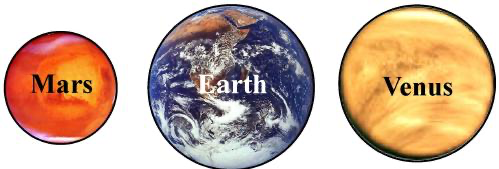
Fig. 10.1. Greenhouse warmings of Mars, Earth and Venus are about 5°C, 33°C and 500°C.
Chapter 10. The Venus Syndrome & Runaway Climate
James Hansen 27 August 2025
Mars, Venus and Earth are the Goldilocks planets – too cold, too hot, and just right. These planets reveal how a planet’s surface temperature depends on atmospheric gases as well as the planet’s distance from the Sun. The physics is energy balance: a planet sends back to space, as (infrared) heat radiation, the energy in sunlight that it absorbs. Absorbed solar energy depends simply on the Sun’s irradiance,
ⁱ the planet’s distance from the Sun, and the fraction of incident sunlight that the planet absorbs (the remainder being reflected). The surface temperature is then given by the Stefan-Boltzmann law¹ (physical principle), if the planet has no atmosphere.
If the planet has an atmosphere that partly blocks heat emission, the surface must be warmer than given by the Stefan-Boltzmann equation for emission to space to match absorbed solar energy.² This “greenhouse” warming depends on how opaque the atmosphere is in the infrared. Mars’ atmosphere has small infrared opacity, so its surface is only a few degrees warmer than it would be with no atmosphere. Venus has a thick atmosphere of (96% CO₂
) with sulfuric acid clouds and water vapor that absorb at wavelengths where CO₂ absorption is weak; resulting greenhouse warming on Venus is about 500°C. Earth has intermediate greenhouse warming, about 33°C, enough to change Earth from an ice ball at –19°C (–2°F) to a hospitable +14°C (57°F).
How did these planets get to this situation?
Can Earth end up like Venus, a lifeless hothouse? Yes, it can, but the runaway greenhouse story described in
Storms of My Grandchildren needs correction. To explain the change, we should first discuss what happened on Venus.
Venus reached an extreme, “baked crust,” greenhouse state. Venus was doomed to permanent climatic hell once it lost its ocean. On a planet with an ocean, CO₂ injected into the air by volcanoes (or humans) gets put back into the crustII within millennia, a geologically rapid time scale. Removal from the air occurs due to weathering: rainfall is slightly acidic (from dissolved atmospheric CO₂
), and plants and animals release acidic compounds, which speeds weathering of rocks. Streams and rivers carry chemicals to the ocean, where CO₂ is deposited on the ocean floor as limestone. Ocean-free Venus, in contrast, has no mechanism for rapid return of volcanic CO₂ to the crust. So much CO₂ is now baked out of the Venus crust and mantle that the surface pressure is 90 times that on Earth, enough to crush any human visitors, if they were not already fried to a cinder.
……
